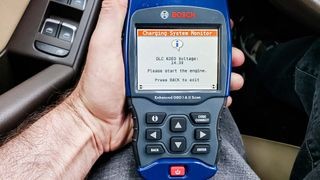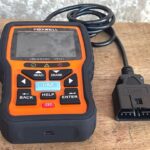The Bosch OBD 1300 is a versatile OBD2 scanner that caters to both modern and classic car owners. This comprehensive review delves into its features, performance, and overall value, providing insights for anyone considering this diagnostic tool. Is it the right Bosch obd2 scanner for your needs? Let’s find out.
Design and Features of the Bosch OBD 1300
Bosch, a renowned name in automotive components, has engineered the OBD 1300 with a compact yet robust design. Measuring 6.8 x 2.6 x 1.0 inches, it’s smaller than many competitors. However, its weight, 10.5 ounces without cables and 1.4 pounds with the included 72-inch extension cord, might feel substantial during prolonged use.
The scanner features a bright blue finish with rubberized grips for comfortable handling. The eight-button interface, including four directional keys, is intuitive but can feel stiff at times. A standout feature is the 3.5-inch color screen, larger than average for handheld scanners, providing clear data visualization.
Powering the OBD 1300 requires four AAA batteries or an external power source via the included cigarette-lighter adapter. A mini-USB port enables software updates. A carrying case ensures organized storage for the scanner and its multiple cables.
Compatibility: Bridging the Gap Between OBD-I and OBD-II
The Bosch OBD 1300’s key strength lies in its extensive compatibility. Beyond the standard OBD-II cable and extension, it includes seven additional cables for pre-OBD-II diagnostic standards, commonly referred to as OBD-I. This makes it invaluable for diagnosing older American and Japanese vehicles manufactured between 1980 and 1995. These legacy cables support standards like ALDL (GM), EEC-IV (Ford), SCI and LH (Chrysler), and Toyota’s round and rectangular plugs.
Performance and Functionality: Putting the Bosch OBD2 Scanner to the Test
In real-world testing, the OBD 1300 quickly identified vehicle models and accurately read VINs. It successfully performed a cylinder balance test, reset the oil light, and diagnosed a deliberately introduced fault (unplugged oil temperature sensor), clearing the Check Engine light.
The integrated CodeConnect database, with over 26 million repair suggestions, offers valuable troubleshooting guidance. The scanner can check ABS and airbag status on vehicles from 1996 to 2013 and perform pre-emissions inspections. Monitoring the charging system and battery health is another useful feature, especially for older cars.
User Experience and Setup
The Bosch OBD 1300 is generally user-friendly, displaying data immediately upon connection. Switching between cables is straightforward. A notable feature is the automatic shutoff after two minutes of inactivity, conserving battery life. This duration is adjustable.
One minor drawback is the lack of printed instructions. Users need to download the Quick Start Guide and user manual from the Bosch website.
Conclusion: Is the Bosch OBD 1300 the Right OBD2 Scanner for You?
The Bosch OBD 1300, priced around $200, offers excellent value, especially considering its broad compatibility with both OBD-I and OBD-II systems. Its ability to diagnose older vehicles makes it a unique offering in the market. While the lack of included instructions and the reliance on batteries are minor inconveniences, the overall performance and comprehensive cable set make it a compelling choice for DIY mechanics and classic car enthusiasts seeking a reliable Bosch obd2 scanner.


